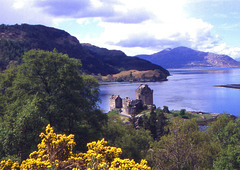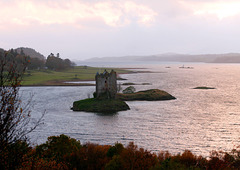
Scottish Lochs
Sloy Power Station Inveruglas 23rd October 2004
Ardgour across Loch Linnhe from Ballachulish 23rd…
| |
|
|
|
Dubh Loch & Fionn Loch from The McLean Path,Letter…
| |
|
|
|
Laithach from Loch Clair Torridon
| |
|
|
|
Liathach is one of the most famous of the Torridon Hills. At a height of 3,461 feet (1,055 m), it lies to the north of the A896 road, in the Northwest Highlands of Scotland, and has two peaks of Munro status: Spidean a' Choire Lèith at the east of the main ridge, and Mullach an Rathain at the western end of the mountain. The name Liathach is pronounced [ˈʎiə.əx] in Scottish Gaelic, and means 'The grey one'. Liathach conveys an aura of impregnability when seen from the roadside below, as the slopes appear to rise up in a series of near vertical rocky terraces.
Eilean Donan Castle Loch Duich from the old Road D…
| |
|
|
|
Eilean Donan (Scottish Gaelic: Eilean Donnain) is a small tidal island where three sea lochs meet, Loch Duich, Loch Long and Loch Alsh, in the western Highlands of Scotland. A picturesque castle that frequently appears in photographs, film and television dominates the island, which lies about 1 kilometre (0.62 mi) from the village of Dornie. Since the castle's restoration in the early 20th century, a footbridge has connected the island to the mainland.
Eilean Donan is part of the Kintail National Scenic Area, one of 40 in Scotland.In 2001, the island had a recorded population of just one person,but there were no "usual residents" at the time of the 2011 census.
Eilean Donan, which means simply "island of Donnán", is named after Donnán of Eigg, a Celtic saint martyred in 617. Donnán is said to have established a church on the island, though no trace of this remains.
The castle was founded in the thirteenth century, and became a stronghold of the Clan Mackenzie and their allies the Clan Macrae. In the early eighteenth century, the Mackenzies' involvement in the Jacobite rebellions led in 1719 to the castle's destruction by government ships. Lieutenant-Colonel John Macrae-Gilstrap's twentieth-century reconstruction of the ruins produced the present buildings.
Sgorr na Ciche & Sgorr nam Fiannaidh across Loch L…
| |
|
|
|
End of the Day Gairloch,Ross-shire,Scotland
View of Loch Long from The Ardgartan Hotel 26th Au…
| |
|
|
|
Loch Long (Gaelic for Ship Lake, Long being the word for ship) is a body of water in Argyll and Bute, Scotland. The sea loch extends from the Firth of Clyde at its southwestern end. It measures approximately 20 miles (32 km) in length, with a width of between 1 and 2 miles (1.6 and 3.2 km). The loch also has an arm, Loch Goil, on its western side.
Loch Long was historically the boundary between Argyll and Dunbartonshire. However, in 1996 boundary redrawing meant that it moved wholly within the council area of Argyll and Bute.
The loch was used as a testing ground for torpedoes during World War II and contains numerous wrecks. It is now a popular area for sport diving. The Ardentinny Outdoor Education Centre also uses the loch for watersports.
Several Scottish sea fishing records are attributed to the loch:
Loch Restil near The Rest and be Thankfull 27th Au…
| |
|
|
|
Dubh Loch from A`Mhaighdean May 2002
| |
|
|
|
Loch Linnhe & Ardgour from The Bridge at Ballachul…
| |
|
|
|
Reflections of Loch Lochy
| |
|
|
|
Loch Lochy (Scottish Gaelic, Loch Lochaidh) is a large freshwater loch in Lochaber, Highland, Scotland. With a mean depth of 70 m (230 ft), it is the third-deepest loch of Scotland.
The Battle of the Shirts was fought at its northern end near Laggan in July 1544, between Clan Donald and Clan Fraser.
The Stand-off at the Fords of Arkaig in September 1665 ended a 360-year feud between the Camerons and the Chattan Confederation. It took place at Achnacarry, on the isthmus between Loch Lochy and Loch Arkaig.
Folklore tales mention 'a supernatural being' called the River Horse which was said to emerge from the lake and assume a horse's shape before feeding on the loch's banks. The River Horse was also known as the Lord Of The Lake and the Water King and would overturn boats and 'entice mares from their pastures'.Another tradition was that of the River Bull, 'a gentle, harmless creature', who would 'emerge from the lake into the pasture of cows'.
Loch Bad an Sgalaig and Baosbheinn(Wizard`s Hill)
| |
|
|
|
Loch Bad an Sgalaig is a small, irregular shaped, freshwater loch and reservoir lying 5 mi (8.0 km) south of the small village of Poolewe, in Wester Ross, Scotland.
The north west end of the loch, where it outflows to the Eas na Laimh stream,was dammed in 1949 to power the Kerry Falls hydroelectric power station.
The loch was surveyed on 30 July 1902 by T.N. Johnston and John Hewitt and as part of the Sir John Murray's Bathymetrical Survey of Fresh-Water Lochs of Scotland 1897-1909.
Castle Stalker,Appin,Loch Linnhe 2nd November 2010
| |
|
|
|
Castle Stalker (Scottish Gaelic: Caisteal an Stalcaire) is a four-story tower house or keep picturesquely set on a tidal islet on Loch Laich, an inlet off Loch Linnhe. It is about 1.5 miles (2.4 km) north-east of Port Appin, Argyll, Scotland, and is visible from the A828 road about midway between Oban and Glen Coe. The islet is accessible (with difficulty) from the shore at low tide. The name "Stalker" comes from the Gaelic Stalcaire, meaning "hunter" or "falconer".
In recent times, the castle was brought to fame by the Monty Python team, appearing in their film Monty Python and the Holy Grail.
The original castle was a small fort, built around 1320 by Clan MacDougall who were then Lords of Lorn. Around 1388 the Stewarts took over the Lordship of Lorn, and it is believed that they built the castle in its present form around the 1440s. The Stewart's relative King James IV of Scotland visited the castle, and a drunken bet around 1620 resulted in the castle passing to Clan Campbell. After changing hands between these clans a couple of times the Campbells finally abandoned the castle in about 1840, when it lost its roof. In 1908 the castle was bought by Charles Stewart of Achara, who carried out basic conservation work. In 1965 Lt. Col. D. R. Stewart Allward acquired the castle and over about ten years fully restored it. Castle Stalker remains in private ownership and is open to the public at selected times during the summer.
For the 2011 census the island on which the castle stands was classified by the National Records of Scotland as an inhabited island that "had no usual residents at the time of either the 2001 or 2011 censuses.
SS SIR WALTER SCOTT at Stronachlachar Pier.Loch Ka…
| |
|
|
|
SS Sir Walter Scott is a small steamship that has provided pleasure cruises and a ferry service on Loch Katrine in the scenic Trossachs of Scotland for more than a century, and is the only surviving screw steamer in regular passenger service in Scotland. It is named after the writer Walter Scott, who set his 1810 poem Lady of the Lake, and his 1818 novel Rob Roy around Loch Katrine.
In 1859 Loch Katrine became Glasgow's main water supply, connected by aqueducts and tunnels to the city more than 30 miles (48 km) away through a hilly landscape. The Trossachs became very popular in the Victorian era, and there were early steamship services on the loch. The Loch is surrounded by wooded mountains, and has romantic historical connections including the birthplace of the outlaw Rob Roy MacGregor. Queen Victoria had a holiday house built overlooking the loch.
William Denny and Brothers built Sir Walter Scott as a "knock-down" ship; that is, it was assembled with bolts and nuts at Denny's shipyard at Dumbarton on the River Leven, the pieces numbered and dismantled again, transported in pieces by barge up Loch Lomond and overland by horse-drawn cart to Stronachlachar pier on Loch Katrine and there rebuilt with rivets and launched. Denny's assembled Sir Walter Scott at their yard in 1899 and completed its reassembly and launch on the loch in 1900.
All ships in the UK must record a measured mile for seaworthiness. Sir Walter Scott completed its measured mile on the Firth of Clyde when bolted together, before being disassembled, transported to Loch Katrine and riveted together again.
Its original cost was £4,269, which included a delivery charge of £2,028.
Sir Walter Scott weighs 115 tons, is 110 feet (34 m) long and has a 19 feet (5.8 m) beam. It is powered by its original three-cylinder triple-expansion steam engine and has two locomotive-type boilers[clarification needed] which until the end of 2007 were fired by solid fuel fed into the firebox by a stoker. At a time when most steamers changed to oil-fired boilers, the Sir Walter Scott kept using solid fuel to meet the requirement of ensuring that Glasgow's water supply is not polluted, changing from coal to coke to reduce air pollution. In a refit at the end of the 2007 season the boilers were altered to run on biofuel. During this refit, the superstructure was rebuilt and a forward deck cabin was added. Some consider the modified superstructure an abomination, destroying the classic lines of this Victorian era steamer. The vessel has a crew of five.
Sir Walter Scott sails from Trossachs pier at the east end of the loch, 7 miles (11 km) north of Aberfoyle) and runs a ferry service 8 miles (13 km) west along the loch to Stronachlachar pier, in the morning and afternoon in spring and summer, taking walkers and cyclists who return by land, then takes those embarking at the pier and those doing the round trip back to Trosachs pier. In the afternoon it also does one or more shorter scenic cruises. In the winter it is taken up on a slipway for maintenance work.
Loch Duich & The Five Sisters of Kintail from Mamr…
| |
|
|
|
Loch Leven from The Pap of Glen Coe 4th May 1990
| |
|
|
|
Loch Maree & Slioch from Slatterdale May 1990`s
| |
|
|
|
Jump to top
RSS feed- Latest items - Subscribe to the latest items added to this album
- ipernity © 2007-2025
- Help & Contact
|
Club news
|
About ipernity
|
History |
ipernity Club & Prices |
Guide of good conduct
Donate | Group guidelines | Privacy policy | Terms of use | Statutes | In memoria -
Facebook
X


















